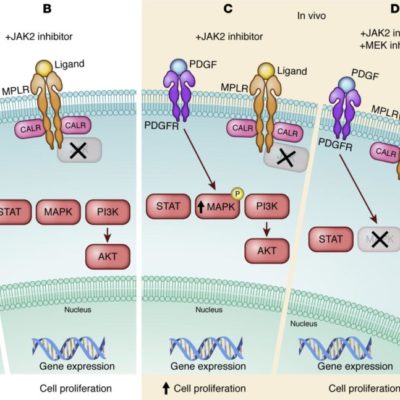enhancing treatment effectiveness in mpns
Targeting JAK2 and ERK Simultaneously
Myeloproliferative neoplasms (MPN) are a group of clonal hematopoietic stem cell disorders characterized by the excessive production of mature myeloid cells (Granulocytes, monocytes, macrophages, and dendritic cells represent a subgroup of leukocytes, collectively called myeloid cells. They circulate through the blood and lymphatic system and are rapidly recruited to sites of tissue damage and infection via various chemokine receptors) and an inherent risk for leukemic transformation. Different subtypes of MPN, such as polycythemia vera (PV), essential thrombocythemia (ET), and myelofibrosis (MF), exhibit distinct clinical phenotypes or presentation of disease symptoms. Dysregulated JAK2 signaling (universal intracellular pathway that has significant functions in many biological processes such as cell proliferation, differentiation, and apoptosis, and immune regulation), caused by somatic mutations in JAK2, MPL, or CALR (genes that play pivotal roles in the pathogenesis of myeloproliferative neoplasms), is a common feature across MPN subtypes. JAK2 inhibitors have been approved for the treatment of MF and PV, but their disease-modifying effects have been limited.
The scientific publication titled “Dual targeting of JAK2 and ERK interferes with the myeloproliferative neoplasm clone and enhances therapeutic efficacy” explores the potential of targeting both the JAK2 pathway and the MAPK pathway, specifically the ERK kinase, as a novel therapeutic strategy for MPNs.
The MAPK pathway, which includes RAF, MEK, and ERK kinases, plays a crucial role in various types of cancer, including MPNs. The researchers hypothesized that simultaneous inhibition of both the JAK2 and ERK pathways could lead to more effective suppression of the MPN clone and potentially improve treatment outcomes.
The study utilized preclinical models of MPNs and tested the effects of dual targeting of JAK2 and ERK using specific inhibitors. The results demonstrated that combined inhibition of JAK2 and ERK led to enhanced suppression of MPN clone growth compared to single pathway inhibition alone. This dual targeting approach also resulted in increased apoptosis (cell death) in MPN cells and reduced the formation of fibrosis in the bone marrow, a characteristic feature of MF.
Furthermore, the researchers investigated the molecular mechanisms underlying the observed effects. They found that dual inhibition of JAK2 and ERK resulted in decreased expression of key genes involved in MPN pathogenesis and dysregulated signaling pathways. This suggests that the combination therapy acts synergistically to disrupt MPN-related cellular processes.
The study also highlighted the potential clinical implications of dual targeting. The researchers discussed the possibility of repurposing existing FDA-approved drugs targeting JAK2 and ERK, such as Ruxolitinib and MEK inhibitors, respectively, for combination therapy in MPNs. Additionally, they emphasized the need for further clinical trials to validate the effectiveness and safety of this approach.
In conclusion, this article provides compelling evidence for the potential therapeutic benefit of simultaneously targeting the JAK2 and ERK pathways in MPNs. The findings suggest that dual inhibition of these pathways leads to improved suppression of the MPN clone, enhanced apoptosis, and reduced fibrosis formation. The study opens new avenues for the development of combination therapies that could improve the treatment outcomes for patients with MPNs. However, further research and clinical trials are necessary to validate these findings and translate them into clinical practice.
.
